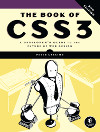The Book & The Author
About The Book
 The Book of CSS3 is for web professionals who have at least a good knowledge of coding with front-end standards, but are looking to find out what’s new and coming soon in the world of CSS. It takes the dense technical language of the CSS3 specification and translates it into language that’s plain and practical.
The Book of CSS3 is for web professionals who have at least a good knowledge of coding with front-end standards, but are looking to find out what’s new and coming soon in the world of CSS. It takes the dense technical language of the CSS3 specification and translates it into language that’s plain and practical.
This book will help you leverage the excellent knowledge you have of CSS2.1 in order to make learning CSS3 easier. It doesn’t explain the fundamentals of CSS (except for the occasional reminder), and it won’t talk you through step-by-step demonstrations of using CSS to make a listed navigation or an image gallery. What it will do is introduce you to what you can do with CSS3 now and show you what you’ll be able to do with it in the future.
With an abundance of real-world examples and a focus on the principles of good design, The Book of CSS3 will help you expand your CSS skills, as you learn how to:
- Style text with custom font choices, drop shadows, and other effects
- Create, position, and resize background images on the fly
- Spice up static web pages with event-driven transitions and animations
- Apply 2D and 3D transformations to text and images
- Use linear and radial gradients to create smooth color transitions
- Take control of layout with grids, columns, and flexible alignment
- Tailor a website’s appearance to every type of web-capable device
About The Second Edition
The second edition of The Book of CSS3 is not just an update but a complete overhaul, with every chapter reviewed, edited and improved.
There are two new chapters: Values and Sizing; and Blend Modes, Filter Effects and Masking. A further four chapters have been almost entirely rewritten to bring them fully up to date with the latest changes to the CSS specification: Gradients; Flexible Box Layout; Grid Layout; and The Future of CSS.
The remaining chapters have been heavily edited to remove non-standard proprietary vendor-prefixed properties, to remove out-of-date references to browser-specific implementations, and to add new illustrations and examples. The browser support tables have all been updated to include the very latest data on implementation.
About The Author
 Peter Gasston has been building websites for many years, starting at the height of the dot-com boom. He has worked freelance and permanent for agencies and corporations, for clients including Google, Samsung, Skype, Cisco Systems and the soccer club he passionately follows, Arsenal. He is now a technologist and front-end lead at digital agency rehabstudio in London.
Peter Gasston has been building websites for many years, starting at the height of the dot-com boom. He has worked freelance and permanent for agencies and corporations, for clients including Google, Samsung, Skype, Cisco Systems and the soccer club he passionately follows, Arsenal. He is now a technologist and front-end lead at digital agency rehabstudio in London.
He specialises in front-end development, mostly HTML, CSS and JavaScript, and keeps his own blog about web technologies, Broken Links
He has written a second book for No Starch Press, The Modern Web, been published in A List Apart, Smashing Magazine and Net magazine, and was for a long time the major contributor to CSS3.info, the blog that arguably started the trend for showcasing CSS3. He talks about the web at professional conferences and local grassroots meetings.
Peter lives in London with his wife, Ana. He loves to read, anything from literature to history and psychology, and is a big fan of independent comics and film. This is his first book.